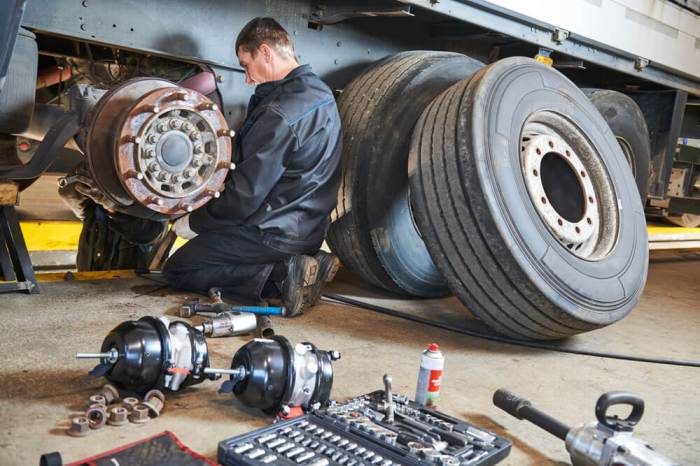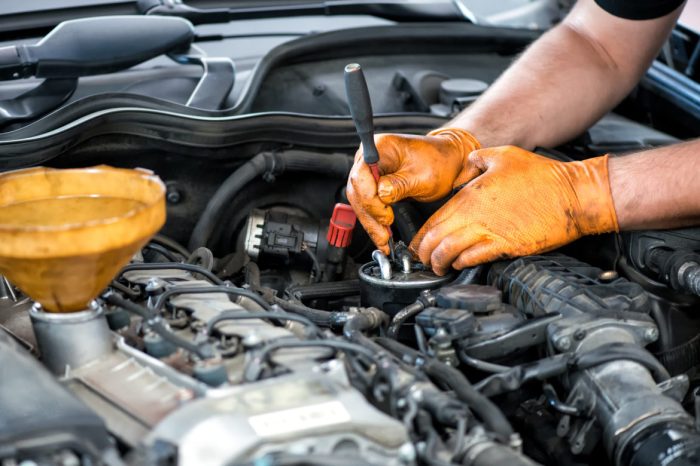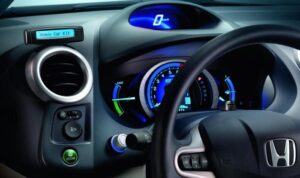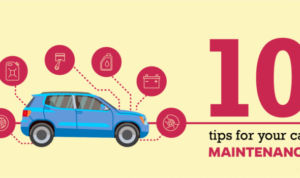When it comes to truck maintenance, staying on top of things is key. From ensuring safety on the road to maximizing performance, this guide dives into the essentials of keeping your fleet in prime condition.
Get ready to explore the ins and outs of maintenance procedures, tools needed, and the impact of proactive vs. reactive approaches. Let’s rev up and roll into the world of truck maintenance!
Importance of Truck Maintenance
Regular maintenance is crucial for trucks to ensure optimal performance and safety on the road. Neglecting maintenance can lead to breakdowns, accidents, and costly repairs.
Impact of Poor Maintenance
Poor maintenance can result in decreased fuel efficiency, engine failure, brake issues, and tire blowouts, putting the driver and other road users at risk. It can also lead to unexpected downtime and loss of productivity for businesses relying on their truck fleet.
Benefits of a Well-Maintained Truck Fleet
A well-maintained truck fleet improves reliability, extends the lifespan of the vehicles, reduces operating costs, and enhances overall safety. It also helps businesses maintain a positive reputation by ensuring timely deliveries and efficient operations.
Regular Maintenance Tasks
- Regular oil changes to keep the engine running smoothly.
- Inspecting and replacing air filters to maintain clean air intake.
- Checking tire pressure and tread depth to ensure proper traction and handling.
- Monitoring brake pads and fluid levels for optimal braking performance.
- Regularly servicing the transmission and cooling system to prevent overheating.
Common Truck Maintenance Procedures

Regular truck maintenance is crucial for keeping your vehicle in top condition and ensuring safety on the road. By following a routine maintenance schedule and inspecting essential components, you can prevent costly repairs and breakdowns. Here are some common truck maintenance procedures to help you keep your vehicle in optimal shape.
Routine Truck Maintenance Check
- Check the engine oil level and quality regularly to ensure proper lubrication and engine performance.
- Inspect the brake system, including brake pads, rotors, and brake fluid, to ensure optimal braking efficiency.
- Monitor tire pressure and tread depth to prevent uneven wear and maintain traction on the road.
- Inspect the battery for signs of corrosion, leaks, or low charge to avoid unexpected breakdowns.
- Check all fluid levels, including coolant, transmission fluid, power steering fluid, and windshield washer fluid, to prevent overheating and component damage.
Inspecting Essential Components
- Brakes: Regularly check for signs of wear, such as squeaking or grinding noises, and ensure brake pads are within the recommended thickness.
- Tires: Inspect tire tread depth, look for signs of uneven wear, and maintain proper tire pressure to improve fuel efficiency and traction.
- Fluids: Follow manufacturer guidelines for fluid changes and top-offs to prevent overheating, corrosion, and component damage.
Importance of Following Manufacturer Guidelines
Following manufacturer maintenance guidelines is essential to ensure proper functioning of your truck and maintain warranty coverage. By adhering to recommended maintenance schedules, you can extend the lifespan of your vehicle and avoid costly repairs.
Tips for Scheduling and Tracking Maintenance Tasks
- Use a maintenance log to track service dates, mileage, and performed tasks to stay organized and ensure timely maintenance.
- Set reminders for upcoming maintenance tasks based on manufacturer recommendations to avoid missing crucial service intervals.
- Work with a trusted mechanic or dealership to create a customized maintenance schedule tailored to your truck’s specific needs.
Tools and Equipment for Truck Maintenance
When it comes to maintaining your truck, having the right tools and equipment is essential to ensure that your vehicle stays in top condition. Whether you’re a professional mechanic or a truck driver handling your own maintenance, having the proper tools can make a big difference in the efficiency and effectiveness of your work.
Essential Tools for Basic Truck Maintenance
- Socket set with various sizes
- Screwdrivers (Phillips and flathead)
- Pliers and wrenches
- Jumper cables
- Tire pressure gauge
Comparison of Different Brands or Types of Tools
- When it comes to socket sets, brands like Craftsman and Snap-On are known for their quality and durability.
- For screwdrivers, investing in a good set from brands like Stanley or Klein Tools can ensure long-lasting performance.
- Pliers and wrenches from brands like Channellock or Irwin are highly recommended for their strength and precision.
Importance of Specialized Equipment
Specialized equipment such as a torque wrench or diagnostic scanner can help you perform specific maintenance tasks with accuracy and efficiency, preventing costly mistakes and ensuring your truck’s optimal performance.
Recommendations for Portable Maintenance Equipment
- A portable air compressor can come in handy for inflating tires on the go.
- An emergency tool kit with essentials like a flashlight, reflective triangles, and a first aid kit can be a lifesaver in roadside emergencies.
- Investing in a portable jump starter can help you avoid being stranded due to a dead battery.
Preventative Maintenance vs. Reactive Maintenance
Preventative maintenance involves regularly scheduled inspections and maintenance tasks to prevent breakdowns and keep the truck in optimal condition. On the other hand, reactive maintenance occurs when a truck breaks down, and repairs are done after the issue has already occurred.
Benefits of Preventative Maintenance
- Increases the lifespan of the truck
- Reduces the likelihood of unexpected breakdowns
- Improves safety on the road
- Helps maintain fuel efficiency
Proactive Maintenance for Cost Savings
Proactive maintenance can help avoid costly repairs and downtime by addressing potential issues before they escalate. By sticking to a preventative maintenance schedule, truck owners can save money in the long run and ensure their vehicles are always in top condition.
Scenarios Requiring Reactive Maintenance
- Unexpected engine failure on the road
- Sudden brake issues during a delivery
- Tire blowouts while driving
It is important to have a plan in place for handling reactive maintenance situations to minimize downtime and get the truck back on the road as quickly as possible.
Environmental Impact of Truck Maintenance

Proper truck maintenance plays a crucial role in reducing emissions and improving overall environmental impact. By ensuring trucks are well-maintained, we can contribute to a cleaner and healthier environment.
Reducing Emissions
- Regularly changing air filters and maintaining proper tire pressure can improve engine efficiency, reducing harmful emissions.
- Timely maintenance of exhaust systems and catalytic converters can help minimize the release of pollutants into the atmosphere.
- Using high-quality engine oil and performing regular oil changes can also contribute to lower emissions levels.
Improving Fuel Efficiency
- Regular tune-ups and engine checks can ensure optimal fuel combustion, leading to improved fuel efficiency and reduced carbon footprint.
- Properly maintaining fuel injectors, spark plugs, and ignition systems can help maximize fuel efficiency and reduce overall fuel consumption.
- Implementing eco-friendly driving practices, such as avoiding excessive idling and aggressive acceleration, can further enhance fuel efficiency.
Eco-Friendly Maintenance Procedures
- Using biodegradable and environmentally-friendly cleaning products for truck washing and maintenance.
- Proper disposal of hazardous waste materials, such as used oil and batteries, to prevent environmental contamination.
- Regularly inspecting and repairing leaks in the fuel and coolant systems to prevent harmful spills and contamination.
Positive Impact Maintenance Tasks
- Replacing worn-out or malfunctioning oxygen sensors to improve fuel efficiency and reduce emissions.
- Maintaining proper wheel alignment and balance to prevent unnecessary fuel consumption and tire wear.
- Checking and replacing air conditioning refrigerant to prevent leaks that can contribute to greenhouse gas emissions.



